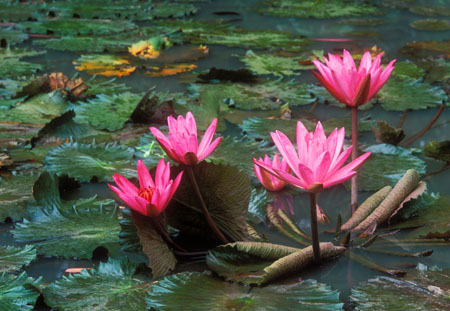Composition is nothing more than the arrangement of the elements of an image in a pleasing manner. Nature is the master of composition but that does not mean that every natural subject is presented with photography in mind.
The process of composing an image is largely intuitive but is also learnt progressively with experience. The eye and brain become gradually more attuned to scenes of a type frequently encountered. A photographer who works with flowers and plants should therefore eventually become acutely sensitive to compositions that please the eye, and recognize them without going through a conscious analytical process.

Balance makes a huge contribution to composition, and may be achieved in a multitude of ways. The proportions of picture elements, their colour and tones, their visual weight and position within the frame are all of significance.In the image opposite, the lilies form a neat triangle and a pleasing diagonal line flowing from lower left to upper right in the frame. The larger and visually heavier blooms are on the right and the visual weight of the group seems to diminish as it flows to the left with the narrowing triangle. The balance of the overall composition is such that the subject seems to "look" to the left, and space has been allowed on the left side of the frame into which the subject can flow.
Diagonal elements of composition are often powerful and should be used wherever possible. Always look for diagonal lines, and implied lines, in every subject. The lines can be formed by stems or the forms and shapes of leaves, by internal venal structures, by colours, shapes and areas of contrast, and by the arrangement of other picture elements as in the image above. Implied lines can be as powerful are real physical lines although they may be invisible to an inexperienced eye. They imply flow and direction, and can lead the eye to explore an image.